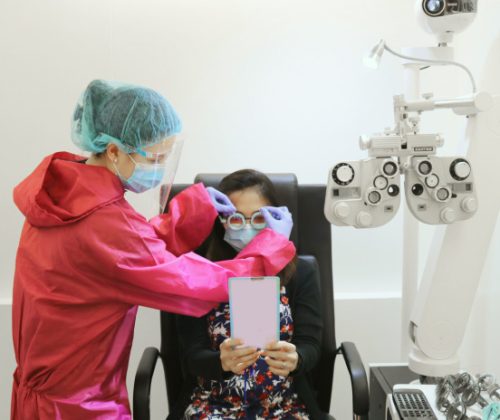We offer a full range of pediatric eye care services, from basic eye exams to advanced treatment of eye problems.
Children can suffer from a unique set of vision ailments, including blurred vision and strabismus (crossed eyes). Although most eye diseases are more likely to occur among older people, children can develop glaucoma or be born with cataracts. Some can be born prematurely with eyes not fully developed. Early detection would certainly be advantageous to have ample time to cure and prevent irreversible conditions.
Whatever your child’s vision problems, we have the training and experience needed to help.

Addressing Common Pediatric Eye Care Questions
The American Academy of Ophthalmology recommends that children have their first comprehensive eye examination between 6 months and 1 year of age. If there are no apparent issues, a follow-up exam is suggested at around age 3 and then before starting school.
Early eye care is crucial for children because undetected vision problems can lead to developmental delays, learning difficulties, and poor academic performance. Identifying and treating eye conditions early can help ensure proper vision development and improve a child's overall quality of life.
A pediatric eye exam typically involves assessing visual acuity, examining the alignment and movement of the eyes, testing for refractive errors, evaluating eye teaming and depth perception, and examining the overall health of the eyes. Additional tests may be performed based on the child's age and specific needs.
It's helpful to explain to your child in simple terms what to expect during the eye exam. Assure them that it won't be painful and that the eye doctor is there to help. Bringing along their favorite toy or comfort item can provide reassurance. For younger children, it may be beneficial to bring snacks or drinks to keep them comfortable during the appointment.
Common vision problems in children include nearsightedness (myopia), farsightedness (hyperopia), astigmatism, and amblyopia (lazy eye). Strabismus (crossed or misaligned eyes) and problems with focusing or tracking can also occur. A comprehensive eye exam can detect and diagnose these conditions.
To protect your child's eyes from injury, encourage them to wear appropriate protective eyewear during activities such as sports, construction play, or using tools. Keep hazardous objects and chemicals out of their reach, and childproof your home to minimize the risk of accidents. Regularly discuss eye safety with your child and emphasize the importance of avoiding eye-rubbing or putting objects near their eyes.
The need for glasses is determined based on the child's vision prescription and specific eye conditions. If your child is diagnosed with refractive errors or other vision problems during an eye exam, your eye care professional will recommend glasses if necessary. The appropriate timing for wearing glasses will be determined by the severity of the condition and the child's age.
Contact lenses can be an option for correcting vision problems in children, depending on their age, maturity, and ability to handle and care for the lenses. Contact lens fitting and usage in children require careful consideration and professional guidance. It's best to consult with an eye care professional to determine if contact lenses are appropriate for your child.